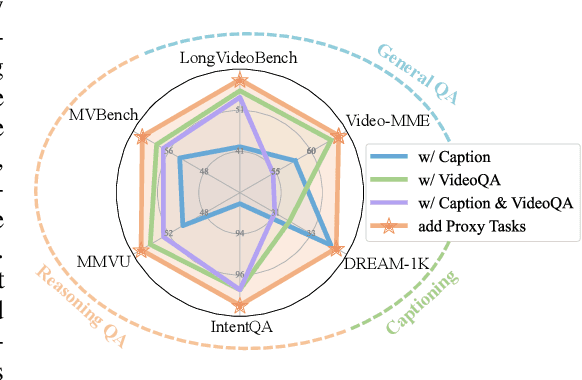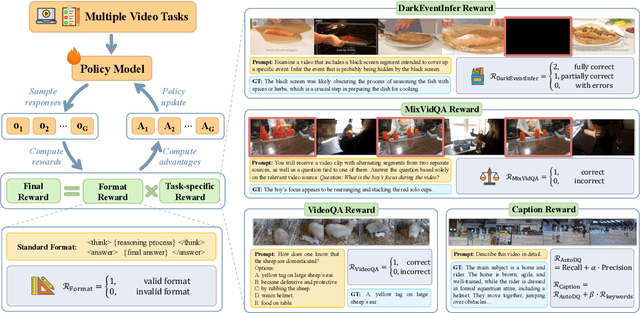Yuanxing Zhang
SWE-Compass: Towards Unified Evaluation of Agentic Coding Abilities for Large Language Models
Nov 07, 2025Abstract:Evaluating large language models (LLMs) for software engineering has been limited by narrow task coverage, language bias, and insufficient alignment with real-world developer workflows. Existing benchmarks often focus on algorithmic problems or Python-centric bug fixing, leaving critical dimensions of software engineering underexplored. To address these gaps, we introduce SWE-Compass1, a comprehensive benchmark that unifies heterogeneous code-related evaluations into a structured and production-aligned framework. SWE-Compass spans 8 task types, 8 programming scenarios, and 10 programming languages, with 2000 high-quality instances curated from authentic GitHub pull requests and refined through systematic filtering and validation. We benchmark ten state-of-the-art LLMs under two agentic frameworks, SWE-Agent and Claude Code, revealing a clear hierarchy of difficulty across task types, languages, and scenarios. Moreover, by aligning evaluation with real-world developer practices, SWE-Compass provides a rigorous and reproducible foundation for diagnosing and advancing agentic coding capabilities in large language models.
Small-Large Collaboration: Training-efficient Concept Personalization for Large VLM using a Meta Personalized Small VLM
Aug 10, 2025Abstract:Personalizing Vision-Language Models (VLMs) to transform them into daily assistants has emerged as a trending research direction. However, leading companies like OpenAI continue to increase model size and develop complex designs such as the chain of thought (CoT). While large VLMs are proficient in complex multi-modal understanding, their high training costs and limited access via paid APIs restrict direct personalization. Conversely, small VLMs are easily personalized and freely available, but they lack sufficient reasoning capabilities. Inspired by this, we propose a novel collaborative framework named Small-Large Collaboration (SLC) for large VLM personalization, where the small VLM is responsible for generating personalized information, while the large model integrates this personalized information to deliver accurate responses. To effectively incorporate personalized information, we develop a test-time reflection strategy, preventing the potential hallucination of the small VLM. Since SLC only needs to train a meta personalized small VLM for the large VLMs, the overall process is training-efficient. To the best of our knowledge, this is the first training-efficient framework that supports both open-source and closed-source large VLMs, enabling broader real-world personalized applications. We conduct thorough experiments across various benchmarks and large VLMs to demonstrate the effectiveness of the proposed SLC framework. The code will be released at https://github.com/Hhankyangg/SLC.
VersaVid-R1: A Versatile Video Understanding and Reasoning Model from Question Answering to Captioning Tasks
Jun 10, 2025



Abstract:Recent advancements in multimodal large language models have successfully extended the Reason-Then-Respond paradigm to image-based reasoning, yet video-based reasoning remains an underdeveloped frontier, primarily due to the scarcity of high-quality reasoning-oriented data and effective training methodologies. To bridge this gap, we introduce DarkEventInfer and MixVidQA, two novel datasets specifically designed to stimulate the model's advanced video understanding and reasoning abilities. DarkEventinfer presents videos with masked event segments, requiring models to infer the obscured content based on contextual video cues. MixVidQA, on the other hand, presents interleaved video sequences composed of two distinct clips, challenging models to isolate and reason about one while disregarding the other. Leveraging these carefully curated training samples together with reinforcement learning guided by diverse reward functions, we develop VersaVid-R1, the first versatile video understanding and reasoning model under the Reason-Then-Respond paradigm capable of handling multiple-choice and open-ended question answering, as well as video captioning tasks. Extensive experiments demonstrate that VersaVid-R1 significantly outperforms existing models across a broad spectrum of benchmarks, covering video general understanding, cognitive reasoning, and captioning tasks.
RICO: Improving Accuracy and Completeness in Image Recaptioning via Visual Reconstruction
May 28, 2025Abstract:Image recaptioning is widely used to generate training datasets with enhanced quality for various multimodal tasks. Existing recaptioning methods typically rely on powerful multimodal large language models (MLLMs) to enhance textual descriptions, but often suffer from inaccuracies due to hallucinations and incompleteness caused by missing fine-grained details. To address these limitations, we propose RICO, a novel framework that refines captions through visual reconstruction. Specifically, we leverage a text-to-image model to reconstruct a caption into a reference image, and prompt an MLLM to identify discrepancies between the original and reconstructed images to refine the caption. This process is performed iteratively, further progressively promoting the generation of more faithful and comprehensive descriptions. To mitigate the additional computational cost induced by the iterative process, we introduce RICO-Flash, which learns to generate captions like RICO using DPO. Extensive experiments demonstrate that our approach significantly improves caption accuracy and completeness, outperforms most baselines by approximately 10% on both CapsBench and CompreCap. Code released at https://github.com/wangyuchi369/RICO.
MME-VideoOCR: Evaluating OCR-Based Capabilities of Multimodal LLMs in Video Scenarios
May 27, 2025Abstract:Multimodal Large Language Models (MLLMs) have achieved considerable accuracy in Optical Character Recognition (OCR) from static images. However, their efficacy in video OCR is significantly diminished due to factors such as motion blur, temporal variations, and visual effects inherent in video content. To provide clearer guidance for training practical MLLMs, we introduce the MME-VideoOCR benchmark, which encompasses a comprehensive range of video OCR application scenarios. MME-VideoOCR features 10 task categories comprising 25 individual tasks and spans 44 diverse scenarios. These tasks extend beyond text recognition to incorporate deeper comprehension and reasoning of textual content within videos. The benchmark consists of 1,464 videos with varying resolutions, aspect ratios, and durations, along with 2,000 meticulously curated, manually annotated question-answer pairs. We evaluate 18 state-of-the-art MLLMs on MME-VideoOCR, revealing that even the best-performing model (Gemini-2.5 Pro) achieves an accuracy of only 73.7%. Fine-grained analysis indicates that while existing MLLMs demonstrate strong performance on tasks where relevant texts are contained within a single or few frames, they exhibit limited capability in effectively handling tasks that demand holistic video comprehension. These limitations are especially evident in scenarios that require spatio-temporal reasoning, cross-frame information integration, or resistance to language prior bias. Our findings also highlight the importance of high-resolution visual input and sufficient temporal coverage for reliable OCR in dynamic video scenarios.
NGENT: Next-Generation AI Agents Must Integrate Multi-Domain Abilities to Achieve Artificial General Intelligence
Apr 30, 2025Abstract:This paper argues that the next generation of AI agent (NGENT) should integrate across-domain abilities to advance toward Artificial General Intelligence (AGI). Although current AI agents are effective in specialized tasks such as robotics, role-playing, and tool-using, they remain confined to narrow domains. We propose that future AI agents should synthesize the strengths of these specialized systems into a unified framework capable of operating across text, vision, robotics, reinforcement learning, emotional intelligence, and beyond. This integration is not only feasible but also essential for achieving the versatility and adaptability that characterize human intelligence. The convergence of technologies across AI domains, coupled with increasing user demand for cross-domain capabilities, suggests that such integration is within reach. Ultimately, the development of these versatile agents is a critical step toward realizing AGI. This paper explores the rationale for this shift, potential pathways for achieving it.
TimeChat-Online: 80% Visual Tokens are Naturally Redundant in Streaming Videos
Apr 24, 2025Abstract:The rapid growth of online video platforms, particularly live streaming services, has created an urgent need for real-time video understanding systems. These systems must process continuous video streams and respond to user queries instantaneously, presenting unique challenges for current Video Large Language Models (VideoLLMs). While existing VideoLLMs excel at processing complete videos, they face significant limitations in streaming scenarios due to their inability to handle dense, redundant frames efficiently. We introduce TimeChat-Online, a novel online VideoLLM that revolutionizes real-time video interaction. At its core lies our innovative Differential Token Drop (DTD) module, which addresses the fundamental challenge of visual redundancy in streaming videos. Drawing inspiration from human visual perception's Change Blindness phenomenon, DTD preserves meaningful temporal changes while filtering out static, redundant content between frames. Remarkably, our experiments demonstrate that DTD achieves an 82.8% reduction in video tokens while maintaining 98% performance on StreamingBench, revealing that over 80% of visual content in streaming videos is naturally redundant without requiring language guidance. To enable seamless real-time interaction, we present TimeChat-Online-139K, a comprehensive streaming video dataset featuring diverse interaction patterns including backward-tracing, current-perception, and future-responding scenarios. TimeChat-Online's unique Proactive Response capability, naturally achieved through continuous monitoring of video scene transitions via DTD, sets it apart from conventional approaches. Our extensive evaluation demonstrates TimeChat-Online's superior performance on streaming benchmarks (StreamingBench and OvOBench) and maintaining competitive results on long-form video tasks such as Video-MME and MLVU.
IV-Bench: A Benchmark for Image-Grounded Video Perception and Reasoning in Multimodal LLMs
Apr 21, 2025Abstract:Existing evaluation frameworks for Multimodal Large Language Models (MLLMs) primarily focus on image reasoning or general video understanding tasks, largely overlooking the significant role of image context in video comprehension. To bridge this gap, we propose IV-Bench, the first comprehensive benchmark for evaluating Image-Grounded Video Perception and Reasoning. IV-Bench consists of 967 videos paired with 2,585 meticulously annotated image-text queries across 13 tasks (7 perception and 6 reasoning tasks) and 5 representative categories. Extensive evaluations of state-of-the-art open-source (e.g., InternVL2.5, Qwen2.5-VL) and closed-source (e.g., GPT-4o, Gemini2-Flash and Gemini2-Pro) MLLMs demonstrate that current models substantially underperform in image-grounded video Perception and Reasoning, merely achieving at most 28.9% accuracy. Further analysis reveals key factors influencing model performance on IV-Bench, including inference pattern, frame number, and resolution. Additionally, through a simple data synthesis approach, we demonstratethe challenges of IV- Bench extend beyond merely aligning the data format in the training proecss. These findings collectively provide valuable insights for future research. Our codes and data are released in https://github.com/multimodal-art-projection/IV-Bench.
Mavors: Multi-granularity Video Representation for Multimodal Large Language Model
Apr 14, 2025



Abstract:Long-context video understanding in multimodal large language models (MLLMs) faces a critical challenge: balancing computational efficiency with the retention of fine-grained spatio-temporal patterns. Existing approaches (e.g., sparse sampling, dense sampling with low resolution, and token compression) suffer from significant information loss in temporal dynamics, spatial details, or subtle interactions, particularly in videos with complex motion or varying resolutions. To address this, we propose $\mathbf{Mavors}$, a novel framework that introduces $\mathbf{M}$ulti-gr$\mathbf{a}$nularity $\mathbf{v}$ide$\mathbf{o}$ $\mathbf{r}$epre$\mathbf{s}$entation for holistic long-video modeling. Specifically, Mavors directly encodes raw video content into latent representations through two core components: 1) an Intra-chunk Vision Encoder (IVE) that preserves high-resolution spatial features via 3D convolutions and Vision Transformers, and 2) an Inter-chunk Feature Aggregator (IFA) that establishes temporal coherence across chunks using transformer-based dependency modeling with chunk-level rotary position encodings. Moreover, the framework unifies image and video understanding by treating images as single-frame videos via sub-image decomposition. Experiments across diverse benchmarks demonstrate Mavors' superiority in maintaining both spatial fidelity and temporal continuity, significantly outperforming existing methods in tasks requiring fine-grained spatio-temporal reasoning.
Generative Frame Sampler for Long Video Understanding
Mar 12, 2025



Abstract:Despite recent advances in Video Large Language Models (VideoLLMs), effectively understanding long-form videos remains a significant challenge. Perceiving lengthy videos containing thousands of frames poses substantial computational burden. To mitigate this issue, this paper introduces Generative Frame Sampler (GenS), a plug-and-play module integrated with VideoLLMs to facilitate efficient lengthy video perception. Built upon a lightweight VideoLLM, GenS leverages its inherent vision-language capabilities to identify question-relevant frames. To facilitate effective retrieval, we construct GenS-Video-150K, a large-scale video instruction dataset with dense frame relevance annotations. Extensive experiments demonstrate that GenS consistently boosts the performance of various VideoLLMs, including open-source models (Qwen2-VL-7B, Aria-25B, VILA-40B, LLaVA-Video-7B/72B) and proprietary assistants (GPT-4o, Gemini). When equipped with GenS, open-source VideoLLMs achieve impressive state-of-the-art results on long-form video benchmarks: LLaVA-Video-72B reaches 66.8 (+4.3) on LongVideoBench and 77.0 (+2.7) on MLVU, while Aria obtains 39.2 on HourVideo surpassing the Gemini-1.5-pro by 1.9 points. We will release all datasets and models at https://generative-sampler.github.io.
 Add to Chrome
Add to Chrome Add to Firefox
Add to Firefox Add to Edge
Add to Edge